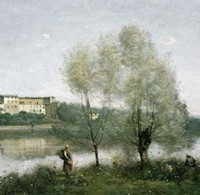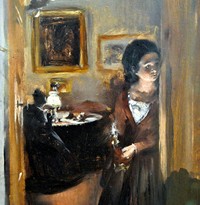|
|
In the case of landscapes by Turner,
the subject is only the basis for reflection of the light and nothing
is better than some of his masses, which have no density in themselves
and which are in perpetual transformation, such as clouds, smoke, steam
or mist, pierced with impunity by the light which only settles in tiny
particles as in a rainbow. See also: English
Landscape Painting 18th/19th century.
Delacroix, who researched
deeply into the masters of the past, particularly the Venetians, senses
the laws of division of colours, of complementaries and contrasts. Signac
was to succeed in his work in putting his name to the origin of all research
in the century. Corot,
the apostle of plein-air painting, remains faithful to the landscape he
is painting but makes it more harmonious, softer and puts more light into
it. Courbet, deeply affected
by the natural surroundings of his youth, always recalls it in tirelessly
composing the old trees and chalk cliffs of his native Jura. (See also
the quasi-Impressionist Italian painting group the Macchiaioli
who were active c.1855-65 in Florence).
But the real forerunners of Impressionist
painters are: Daumier
(1808-79) and the painters of sea and water, Eugene
Boudin (1824-98) and Jongkind
(1819-1891). They also lived through plein-air
painting and practised it throughout their lives. While they were
able, they encouraged and aided their young colleagues in a very definite
manner: Boudin and Jongkind with Claude Monet, and Diaz with Renoir. Sometimes
they painted works which were to foreshadow very accurately their successors.
But in spite of these likenesses, they remained, on a more modest level,
prisoners of their own themes and methods, hemmed in by a description
that was literal and sometimes prodigiously complex (Rousseau), always
strictly tied by their material and limited by reality.
Note also the influence of Japonism
during the 1860s and 1870s (notably Ukiyo-e
woodblock prints by artists of the calibre of Hokusai
and the younger Hiroshige)
on Impressionist painters like Monet, Degas, Mary Cassatt and others.
Also during the 19th century there were
two discoveries so important that artists from then onwards could never
again paint as they had done before: photography and the formulation
of colour laws by Chevreul.
Impact of Photography on Painting
The invention of photography was considered right away to be an extraordinary
means of investigation at the disposal of the painter. It was virtually
the outcome of all means used since the Renaissance
to allow artists to find accuracy and copy nature in a more precise fashion.
Leonardo da Vinci had
already used a process for noting on glass the contour and colour of trees
seen in transparency, and Albrecht
Durer left the design of a drawing machine of this type which he had
invented. Since the 15th century the camera-obscura had
been used to project on to paper inside the camera the exact image of
objects seen through a hole in the side of the box. Vermeer
worked with an optical box. Processes for squaring up landscapes or objects
were in use. In the 18th century the silhouette was invented.
Niepce had the idea of chemical fixation of images in the dark room to
obtain exact reproductions, more accurate than those obtained by engraving,
the sole process used up to that time to reproduce works of art.
The artists were the first to become enthusiastic about the new discovery.
See also: Greatest Photographers (c.1880-present.)
Delacroix joined the Society of Photographers and set about photographing
his models himself (his nudes have a look of Ingres about them).
About 1850, the invention of wet collodion allowed photographs
that previously required long poses to be taken in a matter of seconds.
This made the use of photographs in the open air more easy. About 1860,
Adolphe Braun took his material into the countryside and we saw the photographer-landscapist
as well as the landscape painter. Often the photographers were former
painters, the most renowned being Nadar, a former caricaturist whose photographic
portraits were not inferior to any painting. Having become a friend of
the Impressionists he played an important role in their success.
Photography was to bring the rapid disappearance of engraving reproduction
and even certain forms of painting, such as the miniature, which was replaced
by the daguerreotype. But these were only the lesser forms. As a rival
to painting, photography loses its prestige. Corot uses photographic bases
for strange engravings on glass. But an attempt to use photographic preparation
which only has to be coloured afterwards results in nothing but a sorry
colour print. It results in unjustified discredit to photography which,
if it cannot replace painting, can at least lighten the thankless task
of reproduction and, on a quite different level, provides the artist with
an apprenticeship in viewing and a means of understanding.
It is in fact the best means of first reducing
views of nature to a surface where they assume their proper places. Thus
the landscape is reduced to plans and shapes which the artist can take
as an irrefutable base on which to set up his system of representation.
For him it is a safeguard, a time-saver, a synthetic means of better developing
his analysis. The Impressionists were the first to grasp this and took
great advantage of it.
In certain cases photographic proofs have
been found which served as reference and model for landscape paintings
painted later in the open air. It is possible that this practice was much
more widespread. After eighty years we can photograph most of the sites
painted by the Impressionists and find, despite some superficial modifications,
an almost incredible permanency. From this it may be deduced that either
the painters achieved a remarkable fidelity of what they saw or that they
had recourse to photography as a valuable aid, as a means of seeing better
and making progress.
Impact of Laws of Colour
The discoveries of the chemist Chevreul are of major importance.
Director of the Gobelins tapestry
factory, he published his lessons on chemistry (as applied to colouring
[1828-31]) - and then in 1839 his report on the law of simultaneous
contrast of colours and on the matching up of coloured objects considered
according to this law in its links with painting. Finally in 1864, already
very aged (he was more than 100 years old when he died), his report on
colours, and their application to industrial arts with the aid of chromatic
circles. The chromatic circles, designed by Chevreul for the purposes
of representation, classified colour
in painting in an exact and practical manner and were seventy-two
in number for definite colours, followed by twenty other circles for intermediate
shades.
He divided the colours into primaries
- yellow, red and blue - and binaries, those formed of two colours,
orange (red and yellow), green (yellow and blue), violet (red and blue).
A binary colour is lifted up when alongside the primary colour not contained
in it, which is called complementary - orange with blue, green
with red or violet with yellow.
Having observed that juxtaposition of coloured objects modifies their
optical nature, he formulated the "Law of Simultaneous Contrasts
of Colours."
If two strips of paper with the same
plain colour but different shades are placed parallel with one another
on the same level, the part of the lighter-coloured strip nearer the
darker strip will appear lighter than it is, while the corresponding
part of the darker strip will seem to be darker.
Studying one after another of the seven
prismatic colours, red, orange, yellow, green, blue, indigo and violet,
combined with white, black and grey, Chevreul shows that two strips placed
as above are always modified so that each colour tends to take colour
from its complementary colour; and, if the two juxtaposed strips are coloured
by a common element, whatever its shade, the common element tends to disappear.
Thus the law of simultaneous contrast makes
it possible to see the effect on each coloured object of placing another
coloured object near it. It may be summed up in two points: each colour
tends to give its complementary colour to neighbouring colours, and if
two objects contain a common colour the effect of putting them alongside
one another is to diminish considerably the common element.
Chevreul also studied the different states of visual consciousness. He
called successive contrast the phenomenon which occurs when the eyes,
after resting for a certain time on one or more coloured objects, see
each object modified by its complementary colour, and mixed contrast that,
when the eyes fix on a first series of coloured and then a second, they
find vision diminished in the second series, neutralised by the effect
of the first.
The Impressionists are not scientists but they understood and took
note of these transformations of vision and the new means which they offer:
sometimes in a fragmentary way but for others in a very systematic manner.
They apply these means and discoveries in their own interpretation, but
undoubtedly they find in them an added guarantee. They are interested
in them to the extent that they confirm their own empiric discoveries
and if they feel they are supported by correct scientific theories, they
under-take new research. In fact, this rational experimental method of
creating light by decomposition of tones interests them and helps them
to the extent that it permits them better to depict "a world of emotions
that are personal, subjective, magic". See: Characteristics
of Impressionist Painting 1870-1910.
What makes for the originality of the
Impressionists and results in their group being strictly limited with
no possibility of admitting anyone else to it, is this unique fusion of
science and freedom. From the time of Neo-Impressionism
it was to be quite different. Thus our study will be limited to several
individuals of dominant personality, Edouard
Manet (1832-83), Camille
Pissarro (1830-1903), Edgar
Degas (1834-1917), Claude Monet
(1840-1926); to those who are grouped with them, either individually like
Berthe Morisot (1841-95)
or, by chance from the studios, the group from the studio Gleyre, Alfred
Sisley (1839-1899), Frederic
Bazille (1841-1870), Renoir
(1841-1919); and that of the Academie Suisse, Armand Guillamin, and Paul
Cezanne (1839-1906). There is no minor Impressionist and no name to
add to these except possibly that of Gustave
Caillebotte (1848-94), Those who took part haphazardly or through
the goodwill of Degas in the exhibitions of the group remain absolutely
outside it. It is impossible to cite the names of imitators or followers:
they would be on an entirely different level.
Note: For biographical details of the
French art critic who gave the Impressionists their name, please see:
Louis Leroy (1812-1885).
Reactions to Impressionists
Jules Laforgue, having seen an exhibition
of the Impressionists in Germany, gave a definition of them which, although
restrictive, seems none the less remarkably prophetic. In his estimation
the Impressionist is the painter who uses the sensitiveness of his eye
in direct contact with nature to perceive brilliant scenes in the open
air, to the point of achieving a sort of instinctive vision unhindered
by all the prejudices and convention of his education. With these words,
published in his Melanges posthumes in 1903, he joins the sharpest definitions
by other great minds. Mallarme spoke of Manet's eye as "new, on an
object or persons, steady, pure and abstract", and there is no need
to recall the famous remark of Cezanne on Monet: "He was only an
eye, but what an eye!" It is certain that Monet's eye had exceptional
excitability. But what Laforgue certainly saw was that this development
of a sense helped better to serve a mental attitude. Henceforward Impressionism
is able to go beyond the traditional conventions of the art of painting-drawing,
painting, studio lighting: it suggests shapes and distances by vibration
and colour contrasts; it considers the subject only in its luminous atmosphere
and in the changes of lighting. A landscape bathed in light is made up
of a thousand vibrant clashes, of prismatic decompositions, of irregular
strokes which from a distance melt with one another and create life. "The
Impressionist eye", Laforgue concludes, "is the most advanced
eye in human evolution, that which up to now has seized upon and rendered
the most complicated nuances known." But what is important is that
the means permit of a closer approach to the heart of nature. The Impressionists
are certainly the heirs to that sensitiveness, that belief in progress
and a better world that the 19th century inherited from Rousseau. Each
of the Impressionists could have uttered himself the famous words of Constable,
"I have never seen anything ugly." It is finally incompatible
with realism and naturalism defined by Zola. And that is why the latter,
remaining shackled by his heavy formulas, was to end up by breaking all
contact with the painters who had been his friends when he was a youth.
Impressionism should evoke for us an intimate
participation in worldly life. Pantheism, unanism and pluralism are hardly
strangers to it. It becomes a fusion of the vegetable kingdoms and an
extension to cosmic proportions of their peculiarities. In the dark and
austere forests of Barbizon it blossoms out suddenly like flowers blooming;
nature is transformed into intangible particles, density melts into luminous
blotches. The same coloured magic surrounds objects and figures whose
skin is coloured by other reflections. Water lends itself to all the reflections.
D'Ors wrote about Monet completely filling
five or six canvases and changing them every half-hour to reproduce the
changes in the Cathedral at Rouen (or in haystacks) and the transitory,
fleeting moment.
However, the accomplishment of individual works by the greatest Impressionist
painters, Cezanne and even Renoir and Monet, carries its own indispensable
antidote. This cult of the ephemeral, in which images from the passing
hours, from variations of the light of the day, from the intensity of
emotions aroused, could not hide the fact that durable reality remains,
in structures, framework and also ideas. The water flows on, never the
same, but the river remains. For more, please see: Best
Impressionist Paintings.
For the Impressionists everything is landscape, even objects from fruit
to the most concrete structures and all the elements that are assembled
in still-life. Paul Cezanne, who goes farthest in organising a new painting
form, when he paints figures in innumerable sittings, is not interested
in the character of his model but in the extraordinary richness and variety
of the coloured facets of the face, which are divided up and superimposed
like those of a mountain. There is a constant exchange between the appearance
of the person and the air which surrounds him, the light which strikes
him. The structure he pursues relentlessly and finds is that of nature.
A head is like a rock, a body like a tree. The result is that those men
or women bathing are like pines inclined in his own forest. Cezanne always
succeeds in mastering his own effusiveness. To exhaust all the possibilities
of his few themes, to which he returns incessantly, he creates a hierarchy,
an order, and sets up a rhythm. This is expressed in the treatment of
essential shapes and recourse to elongation and deformation. Cezanne thus
creates a new appearance, more lasting and significant than that of the
moment, but always subservient to nature.
To see how Monet's 'naturalism' paradoxically
paved the way for 20th century abstraction, see: Realism
to Impressionism (1830-1900).
Yes, Impressionism is a great body of which
all the members have developed harmoniously. The most eminent historian
of the movement, Lionello Venturi, was right in considering the Impressionists
as complementing one another, each with his own particular virtues: "joy,
animation and the spirit of the picture expressed by Renoir; the soul
of things by Monet; the mastery, no less of the unsophisticated world,
by Degas; grandeur, refinement and enormous knowledge by Cezanne; rural
religiousness and epic breadth in Pissarro; finesse and tranquillity in
Sisley".
Read about Impressionism's greatest supporter:
Paul Durand-Ruel.
NEXT: (2) Early
History of the Impressionists.
Acknowledgements:
We gratefully acknowledge the use of an excerpt from Impressionism,
by Jacques Lassaigne (1966).
|



